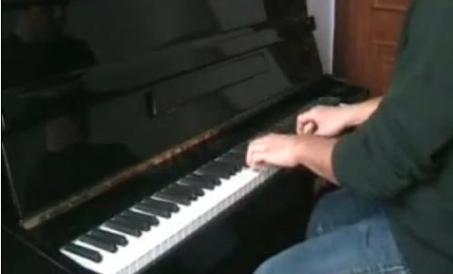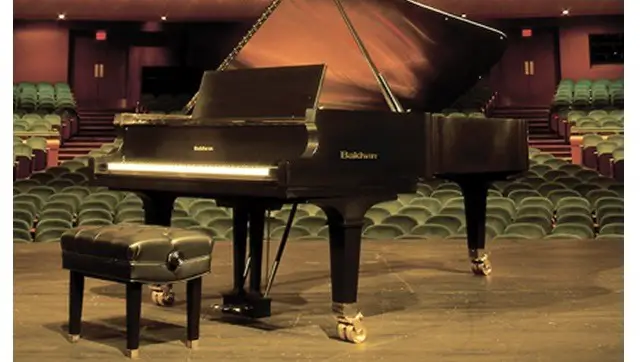
Baldwin Piano, a leading Piano brand and one of the largest Piano manufacturer in the United States and a respected name in the music industry. It makes Grand, Upright and Custom Pianos. The Baldwin Piano business has seen many ups and downs over the years and is now owned by Gibson Guitar corp (leading Guitar Brand). It manufactured acoustic pianos under the brand names – Baldwin, Chickering, Wurlitzer, Hamilton, and Howard.
Baldwin Piano Company – The Beginning
The story of Baldwin Piano passes through the Civil War, the Great Depression and two world wars. It survives two fires. And it includes a family dynasty that doesn’t even bear the name Baldwin.
Before its fall, decimated by bankruptcy and sold in 2001, Baldwin employed thousands of people in factories and dealerships across America – many of them local builders, technicians, master craftsmen and engineers.

By 1873, Baldwin (a music teacher) and Lucien Wulsin (a young man who had finished his business schooling, after the Civil war ended) had formed a partnership, with Wulsin contributing $10,000 in family cash. A decade later, three more partners joined the venture. Their business model was the sewing machine industry, using local dealers. By 1898, the company was worth a half million dollars with factories on Gilbert Avenue and Downtown. They also owned the Hamilton Organ Co. in Chicago.
As Wulsin became the visionary leader, Baldwin retreated from the company. The business might have died right there had Wulsin not galvanized his partners to buy it back. Owning the company wasn’t enough for Wulsin. He wanted Baldwin to create a musical instrument of unsurpassed quality.
Baldwin Piano Company – The Rise
Mr. Wulsin not only wanted to make a good, affordable piano, he wanted ‘Baldwin’ pianos to be the best pianos. Around 1890, Wulsin called in the company’s staff piano tuner John Warren Macy and told him, “Make the best piano that can be made.”
He did.
Macy had grown up in Troy, Ohio. He taught himself to be a church organist at age 14 and later, a tuner. He was fascinated by the art of acoustics and everything to do with pianos, from the strings to the cabinetry to the soundboard.
He carried a pencil and a pocket-sized leather-bound journal where, in meticulous handwriting, he recorded calculations, measurements of strings and sketches of piano key mechanisms.
He reported to Wulsin that he had visited the Decker Brothers piano factory in New York, where he took detailed notes about the process, quality of materials used, the standard of skill required and how much it might cost to build a piano.
For Macy, who produced the first piano in 1891, the piano’s sound was the most critical element. His handwritten treatise explains that, of all the instruments, the piano offered to “even the most critical ear the choice of a tone quality that will meet its wishes.”
In 1900, Macy’s (and Wulsin’s and Baldwin’s) piano won the Grand Prix at the Paris Exposition. The jury included the New York music critic Henry Krehbiel, a Cincinnati native and Wulsin boyhood pal.
But the praise was not limited to those who knew Wulsin. The piano won again in 1904 at the Saint Louis Exposition and in 1914 at the Anglo-American Exposition in London.
(Local history buffs say the gold-medal piano finally ended up at Macy’s home on Wyoming Avenue in suburban Wyoming, to be played in the parlor by his daughter, Carolyn.)
It was the Paris Exposition that launched the Baldwin piano as one of the world’s great musical instruments. Three generations of the Wulsin family would build the company to international stature, rivaled in America only by Steinway.
And the Wulsin marketing strategy soon became “put a Baldwin in every home.” For, unlike Steinway, which catered mainly to artist-caliber musicians, Baldwin also made pianos for the average American.
Do you hear any difference between a Steinway model D, built in July 2001 and a Baldwin SD-10, built in Nov. 1992? Amanda Rossmann
For the smaller, spinet pianos, the name “Acrosonic” was born – derived from Greek and Latin for “good sound.” Other labels used over the years included Hamilton (pianos and organs), Howard and Ellington.
In 1922, Cincinnati’s WLW Radio went on the air with a Baldwin piano, preferring its clear tone for broadcasting over that of any other piano.
Baldwin soon became the best-selling pianos in America.
Cincinnati, with its immigrant craftsmen, was the perfect city to set up a factory making these hand-made masterpieces. (When master woodcarver John Giglio of North College Hill died, his obituary proudly declared that the Italian immigrant had personally carved the Baldwin grand piano played by Liberace.)
And while the Wulsin name is not as familiar in this town as Taft or Longworth or Emery, maybe it should be. The first Lucien Wulsin had a hand in founding the Cincinnati Symphony Orchestra, Cincinnati May Festival and the Conservatory of Music. With foresight as to what the city needed beyond music, he helped to establish the Park Commission and Park system.
Wulsin II cultivated artists and orchestras, going to concerts from coast to coast. During those years, he had a special relationship with the Boston Symphony Orchestra, providing pianos in Boston and for its summer home at Tanglewood.
Lucien Wulsin II, the president of the Baldwin Piano Company would have several famous artists come home every evening (in the family’s 30-room Hyde Park mansion), who would practice on the two Baldwin baby grands (placed in the living room) all through the night. Next morning, Mr. Lucien would take the pianists to the factory to help them pick a grand piano for their upcoming concert.
“I stayed with Baldwin primarily because of the human personal connection I had with the Wulsins and with the artist representatives,” said concert pianist Lorin Hollander, a former Baldwin artist who first performed in Cincinnati in 1959.
Back home, the Cincinnati Symphony and the University of Cincinnati’s College-Conservatory of Music benefited from the same policy. They were given pianos free of charge, often with a technician thrown in.
Wulsin II weathered the Depression, which wiped out many piano companies, pouring company resources into developing new electronic organs in the late ‘30s.
Then, just as Baldwin sales reached a peak, the attack on Pearl Harbor thrust the nation into the next war. Overnight, he converted the piano company into a factory for making airplane wings and gliders for use on the battlefield. It was no small feat to revert it back to pianos at the war’s end.
Wulsin II died in 1964, never forgetting the man who had founded the company he loved. He remembered seeing the aging man with a long beard, eating a large plate of ice cream at a company party. D.H. Baldwin, he once wrote, was “one of the powers in the development of culture in the United States.”
Lucien Wulsin III – a purple heart veteran who had fought at Normandy in World War II – took over the company after his father’s death in 1964. Even though it was still in family hands, her brother didn’t seem to have the passion of the others.
Baldwin Piano Company – The Downfall
By the mid-’70s, most of the manufacturing had moved to the south. The last parts that were crafted in Cincinnati were the “rims” – the defining form of the piano – recalled local workers. Organs had become such a big part of the business that the company changed its name to the Baldwin Piano and Organ Company.
Yet company traditions endured. When Don Gibbs worked in the company’s grand piano research and development area, he went to work in a suit and tie. He learned how to build a prototype concert grand from company legends such as R&D head Harold Conklin. He maintained pianos for stars such as Jorge Bolet and Aldo Ciccolini. He remembers going with André Watts and other pianists to Music Hall, for “tone tests” using five pianos onstage.
“Lucien Wulsin III wanted a bigger, better concert grand, that would get recognition on the concert stage. Those ideas would then be scaled into smaller pianos,” Gibbs said.
Wulsin III retired in 1981.
Then, it ended. But not immediately.
In the first wave of layoffs, Gibbs was told to clean out his desk and leave, along with many others, in 1981.
“You saw grown men crying as they left the building that day,” he recalled.
Baldwin diversified into banking and electronics, becoming Baldwin United. By 1983, it filed for bankruptcy. In 1986, the piano division went public as the Baldwin Piano and Organ Co., which also sold grandfather clocks. In November of 2001, Nashville-based Gibson Guitar Corp. purchased the struggling company from GE Capital, Baldwin’s largest creditor.
Today, the Trumann, Arkansas, Baldwin factory sits like a ghost, full of machinery, as if its workers have just gone to lunch. The Baldwin headquarters building, which is on the National Register of Historic Places, is undergoing a $100 million makeover as loft-style apartments. Gibson Guitars now makes a piano under the Baldwin label in China.
Shortly after Wulsin II died in 1964, a spectacular fire at the Baldwin factory on Gilbert Avenue made national news. Fortunately, it was the building that only held wood for the pianos.
Baldwin’s Cincinnati Sound
The Baldwin piano has been praised for possessing a clear, bright, bell-like tone and a resonant, rich bass. For pianist Lorin Hollander, a Baldwin artist for several decades said its strength was its “ease of execution.”
“It had a clarity, a gentle, very pleasant, lovely sound, and it could have tremendous power. One had to be careful about banging, hitting too hard. It went up to a point where it started to get percussive.” the pianist said.
Baldwin concert grand model, the SD-10, was used on the CSO World Tour of 1966, sponsored by the U.S. State Department. Hollander, then 22, played Baldwin’s SD-10 concert piano, all along a grueling, 42-concert tour with stops in Istanbul, Tel Aviv, Bombay, Beirut, Singapore, Hong Kong, Taipei, Tokyo and Seoul. The piano was dropped “more than once” and pushed over cobblestone streets; Baldwin sent a piano technician to put it back in shape for the six concerts in Tokyo, Hollander recalled.
Baldwin pianos were played and endorsed by the greatest stars in music: Pianists José Iturbi, Earl Wild and Claudio Arrau, Broadway’s Stephen Sondheim, composers Aaron Copland, Philip Glass and Leonard Bernstein, and jazz musicians Dave Brubeck and Marian McPartland, who used a Baldwin for her show “Piano Jazz” on National Public Radio.
Four United States presidents brought Baldwins to the White House, including Harry Truman. He remarked about the beautiful piano “made by an American company named Baldwin,” and played a few chords during a televised 1952 White House tour.
It was soon enough on TV every weeknight as Paul Shaffer’s choice on NBC’s “Late Night with David Letterman,” and on many episodes of Fox’s “Glee.”
The Baldwin became a favorite of jazz pianists and pop artists such as Carly Simon, Ray Charles and Billy Joel. Entertainer Michael Feinstein famously changed the lyrics of Irving Berlin’s “I Love a Piano,” to include, “I’m just appalled when it’s not a Baldwin.”
Source: cincinnati.
Baldwin Piano Highlights
The following are some of the highlights of Baldwin Pianos.
Incorporates 41-Ply Pinblock design, which offers exceptional tuning stability
Most pianists love their Baldwin, especially if it is an antique one and has been passed down to you from your family. These are also good for those who are looking for fairly inexpensive ones. Steinway is also good but most find it expensive.
Website: Baldwin Piano.
Various Products
Baldwin is now owned by Gibson Guitar Corp. and under it leadership it continues to offer pianos under the brand names – Baldwin, Chickering, Wurlitzer, Hamilton, and Howard.
It offers a wide range of acoustic and digital pianos in both upright as well as grand cabinets, the Wurlitzer digital pianos being popular for its amazing capabilities.
You can even order a custom designed Piano, if you wish to. You can ask them to make some changes to the design based on your personal preferences.
The color, wood finish, carvings, etc. can be modified according to your needs.
The latest products from Baldwin include the ConcertMaster Complete Player System and the Baldwin ConcertMaster Compact Disc System. These are digital accessories that can be fitted to your Baldwin piano to turn it into a complete entertainment system.
These systems come with features like ability to record your performances, built-in accompaniments, ability to play CD’s and a lot more.
User Comments…
Baldwin Pianovelle RP150: Circuit board needs to be replaced
by: Anonymous
I bought this piano for a really good price. Some of the lights go on, but there is no sound. I have had someone tell me that the “battery” pack has corroded and damaged my motherboard and his prices for repair were beyond unbelievable. Is there someone or somewhere that would help me with this and be willing to quote a reasonable price? This guy is quoting like 4 times what it would cost for a brand new one. Thanks
Locating the Battery in Digital Pianos
by: Suresh
Few queries regarding batteries have been posted, so here are some thoughts.
Few things to keep in mind in case you are attempting the repair on your own. In the case of digital pianos, it is best to have the service manual nearby before you attempt opening it.You will also need a Screwdriver set, and in case you really intend to do all the detective work yourself, you will also need a multimeter, and soldering, desoldering tools. This is to be tried only incase the factory reset doesn’t work!
Once you open up the body, you should be able to find a silver colored coin-shaped battery. Most internal batteries are of this type. If you have been using your instrument for several years, you will need to replace it with a new lithium ion cell battery. Just slide the battery out of its holder, and insert the new one. However, if the battery is one of the less-commonly used types (the service manual should tell you that) and is soldered, you will need to do some work. this is where the tools come in to play. To remove the existing soldering, you’ll need to heat it up with the soldering iron and then use the desoldering tool to remove the excess solder (avoid direct contact with the battery). Now you can insert the new battery in place.
Baldwin Piano Repair
by: Elvis (Arkansas)
We have a Baldwin Pianovelle RP100 (made by General Music). It will power on but not work. From posts on the internet I suspect it is a battery that has leaked on a circuit board. I removed the top cover and check the circuit boards that I found and did not find a battery or any damage to a ciruit board. I need to know the location of the battery and how to get to it. We also have a Baldwin DVP-80, and think that the internal battery might need to be replaced, but we don’t know where it’s located-how to get to it.
Baldwin Pianovelle RP150 Digital Piano does not turn on
by: Norma King (Staten Island, New York)
My Baldwin Pianovelle RP150 Digital Piano does not turn on and there is no sound…
I have Baldwin Pianovelle RP-450 for about 9 years. It does not totally switch on and there is no volume and none of the prompts on the piano light up. I never had a problem until this summer. My piano is in my basement. I’m beginning to believe that the dampness may have affected my piano. I also believed that because it was digital there would not be a problem. Perhaps I was incorrect. Can someone please help me in solving this problem on my Baldwin Pianovelle RP150 digital piano or point me in the right direction. Thank you
Baldwin Digital Piano – Pianovelle Series
by: Thanh Nguyen (Rochester, NY, USA)
My Baldwin Digital Piano got damaged from water spill…
I had a party at home and there was a young kid who accidentally spilled water on my digital piano. Didn’t pay much attention on that day, but two weeks later when I wanted to play the piano, there were 5 keys that could not make sound. I think the electronic of these 5 keys are shorted from the result of water spill. Anyone has any suggestions on how to fix the problem on my Baldwin Digital Piano or where I can get for help?
KeytarHQ editorial team includes musicians who write and review products for pianists, keyboardists, guitarists & other musicians. KeytarHQ is the best online resource for information on keyboards, pianos, synths, keytars, guitars and music gear for musicians of all abilities, ages and interests.



Leave a Reply